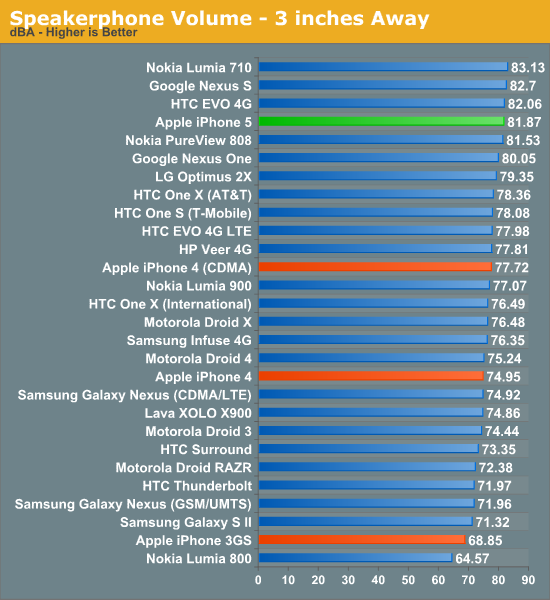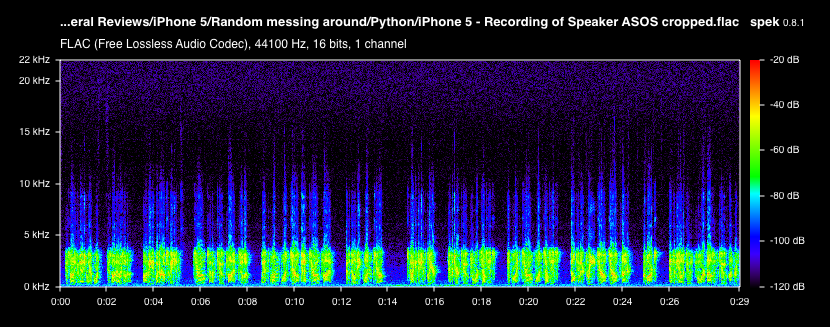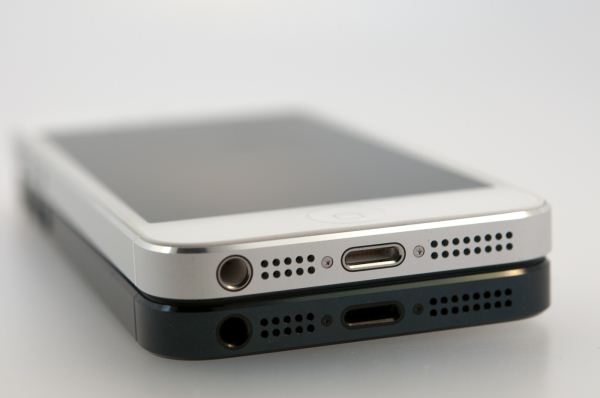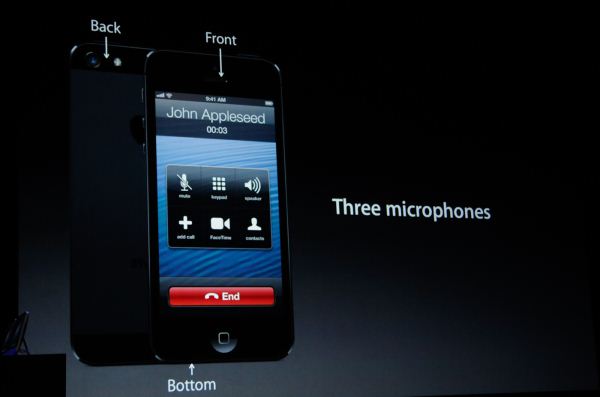The iPhone 5 Review
by Anand Lal Shimpi, Brian Klug & Vivek Gowri on October 16, 2012 11:33 AM EST- Posted in
- Smartphones
- Apple
- Mobile
- iPhone 5
Speakerphone and Noise Suppression
Section by Brian Klug
When Apple changed up the dock connector with the smaller Lightning port, it afforded a chance to also redesign the speakerphone at the bottom of the iPhone 5. Between the iPhone 4 and 4S we saw minimal changes, and performance was acceptable if a bit on the quiet side. With the iPhone 5 Apple advertised a big gain in audio quality with both changes to the speaker and a 5 magnet transducer design.
We normally test speakerphones by calling the local ASOS test number at max volume in front of an Extech sound data logger sampling continually and then averaging over one readout of the weather report. This gives a good feel for the overall loudness of the speakerphone on a call, but doesn’t tell us anything about quality unless you’re standing in front of it. In this case, the iPhone 5 is quite loud and comes in near the top of our scale at 81.8 dBA. It isn’t chart topping but a definite improvement over the relatively quiet 4/4S speakerphone design.

I decided to do something different though after getting a lot of questions and emails asking for a better quality comparison between the iPhone 5 speaker and its predecessor. People are interested in using their smartphones to listen to music when speakers or a dock aren’t available, and I thought this worth investigating. To get to the bottom of this I used my Blue Yeti USB microphone and arm which I use for podcasting to record the speakerphone output at 90 percent volume on the iPhone 4S and iPhone 5.
I started with the test call, which sounds surprisingly different between the iPhone 4S and iPhone 5. The 4S saturates and has obvious distortion even at 90 percent volume. This is quite noticeable in the recording. It then occurred to me that because I’m calling over AT&T (narrowband AMR) and to a PSTN (public switched telephone network) that the call would be limited to 4 kHz thanks to filters along the route, therefore anything above 4 kHz is undesirable. I took a spectral analysis (which shows power spectral density), and instantly it became obvious just how much energy there is on the 4S above the 4kHz limit from overmodulation or saturation/clipping on that speakerphone design. Meanwhile the iPhone 5 has much less energy over that 4 kHz maximum for a PSTN call.
I did the same for two songs recorded start to finish, and the differences are quite noticeable even in my rather quick and dirty recording plus spectogram comparison. I cropped the two recordings of the songs quite a bit and stuck them on soundcloud.

My overall impressions with the iPhone 5 speakerphone is that it has much less of a tendency to clip and saturate than the 4S, all while being noticeably louder. It’s still a smartphone speakerphone but to my ears the difference is pretty dramatic.
Noise Suppression
We’ve known for a while now that Apple changed up the slot for noise cancellation in the iPhone 5. The story goes something like this — Audience was a discrete chip on the iPhone 4, an IP block on the A5 SoC for iPhone 4S, and also an IP block onboard the A6 SoC for iPhone 5. The difference is that with iPhone 5 Audience isn’t enabled, and the company knows this because final characterization with both the final industrial design, microphones, and performance was never performed. Audience claims it met all of its deliverables and targets with the new IP block it built and gave Apple for inclusion on the A6. There’s obviously a lot of speculation about exactly why Apple chose to go with its own soultion versus Audience.
We’ve seen Audience earSmart noise suppression processors in a number of smartphones to date, and carriers often have their own specification for noise suppression to get certified. In addition, with wideband voice (AMR-WB in the case of the iPhone 5) noise suppression is even more important, to say nothing of how big of a topic this is with voice recognition based features like Siri. While we’re on the subject of AMR-WB, this feature is enabled on the iPhone 5 but I’m unable to test it on any of the carriers in the USA at the moment.
Anyhow, the iPhone 5 uses an Apple-specific solution with three total microphones all around the device. One primary microphone at the bottom of the device where you’d expect the primary microphone to reside, a secondary microphone between the LED flash and camera module, and a third right next to the earpiece for use with earpiece active noise cancelation. Apple’s solution is a beamformer (Apple said so in the keynote) and from what I can tell thus works entirely in the time domain. I’ve spent a lot of time playing around with the iPhone 5 trying to characterize its noise rejection, and the system appears to have a number of modes it will kick into after a 5–10 second adaptation time.
Earpiece noise rejection is something I talked about on the podcast right after the iPhone 5 hands on, and is one of those modes that the iPhone 5 will kick into if you’re in a loud environment. It isn’t active all the time, but when it does transition into working it provides a noticeable suppression of ambient noise and the same kind of pressure I’ve felt with other active noise canceling closed ear headphones. The improvement isn’t overwhelming, but it’s a sensation and feature I haven’t experienced on any other smartphones to date.
The rest of the noise suppression story is really one of testing. To test, I ran our normal test suite which consists of me ramping ambient music to 94 dBA while speaking into the device under test and recording the other side of the call. I’ve gotten ahold of the industry standard babble and distractor tracks used by carriers for testing noise suppression and will move to those in the future, for now though the test track I currently play is something I understand pretty well.
The comparison here is between the iPhone 4S and iPhone 5 to see just how ambient noise suppression has changed with this change in solution. The difference in technique is pretty apparent, and again indicates to me that the iPhone 5 is working in the time domain. You can see visible cut in and cut out on the waveform. The Audience solution has some hiss that develops at the absolute highest background noise volume on the 4S, but it also does an excellent job suppressing noise. The Apple solution doesn’t have this hiss, but passes both background noise and vocals from the music passed through the call at maximum volume. I hate to call this a regression, but the difference in technique means that there’s audible background noise that gets passed on while I’m talking on the iPhone 5. I think for normal callers the difference won’t be readily apparent, but with close inspection it is dramatic.













276 Comments
View All Comments
youwonder - Wednesday, October 17, 2012 - link
I find it kind of ...odd that the S3 has a much larger battery than the one X and the same SoC yet posts significantly worse LTE browsing numbers, and is the only phone using LTE to get worse results with it than using 3G(granted that is the international vers, doesn't look like they had time to do testing on the AT&T or verizon variant running 3G). Does the samoled screen really draw THAT much more power than an LCD? also there's this which makes me wonder more:http://blogs.which.co.uk/technology/smartphones/be...
Of course, I don't respect these guys as much as anandtech when it comes to accurate results, and they did things much differently (broadcasting their own 3g signal and putting all phones on max brightness), but still the odd results here make me wonder if a small mistake wasn't made.
Zink - Wednesday, October 17, 2012 - link
Max brightness gives the gs3 an advantage because its screen is so dim. The other phones are using LED lighting as well but they go much brighter and have to shine through the LCD panel.youwonder - Wednesday, October 17, 2012 - link
Good point, I guess it's mostly just me wondering why the GS3 LTE variant posts such horrible numbers even compared to it's 3G version when anand specs a good amount of time explaining why the opposite is true.phillyry - Sunday, October 21, 2012 - link
Don't know why but it does tank on LTE.rarson - Wednesday, October 17, 2012 - link
I'm getting so sick and tired of seeing the word "literally" injected into all sorts of sentences that it doesn't belong in. This word only needs to be used when describing something literal. It's not a synonym for "really" (not yet, anyway).andykins - Wednesday, October 17, 2012 - link
Alright, language purist. :Pjoos2000 - Thursday, October 18, 2012 - link
http://theoatmeal.com/comics/literallyphillyry - Sunday, October 21, 2012 - link
Great link. That's too funny - literally!dfonseca - Wednesday, October 17, 2012 - link
On the last page, section "Final Words" / "iPhone 5 Device Conclusions", it's written:> At a high level, the iPhone 5’s cameras appeared to be some of the least unchanged elements of the new device however in practice the improvements are significant.
"Least unchanged" means "most changed." It should probably say "most unchanged," or "least changed."
Nice review, kudos to all authors.
mattlach - Wednesday, October 17, 2012 - link
I had the original iPhone, followed by the iPhone 3G and then the iPhone 4, and just switched to a Samsung Galaxy S3 in July.When the original iPhone came out, while it was the first to do what it did - and that's why I bought it at its steep no-contract introductory price - it wasn't exactly revolutionary, everything in the market was moving in this direction, but it was pretty well executed and nothing else did it at the time.
I upgraded to the 3G on launch, as I thought the edge speeds were dreadful, but was disappointed, as the phone wasn't fast enough to take advantage of 3G, and AT&T's 3G was pretty mediocre anyway. It didn't get important features its competitors had, like copy and paste until very late in the game, and I started to think that I should have gotten an Android phone instead.
By the time I got the iPhone 4, I was tired of my slow 3G experience and just wanted an upgrade to something faster. The iPhone 4 was a good upgrade, but I really only got it because I didn't like AT&T's Android offerings at the time. I had been thinking about going to Verizon and getting an Android for some time. The 3G should have been my last iPhone, it was a mistake to buy the 4.
Having realized my mistake, I waited 2 long years with the 4 until I could finally get out of my AT&T contract and go to Verizon and get a GS3, and it felt great.
The additional freedom of what I run on my phone, not being controlled by Apple and their agenda as to what makes it into the App store, and the fact that I finally no longer had to have iTunes installed on my computer were fantastic.
My computer has been iTunes free for 3 months now, and it feels great!
I was concerned for a while that once the iPhone 5 was released, they would come out with something that would make me regret my choice of the GS3, but it turns out they didn't.
I'll likely never buy anything Apple again. It feels like a huge relief to say that.